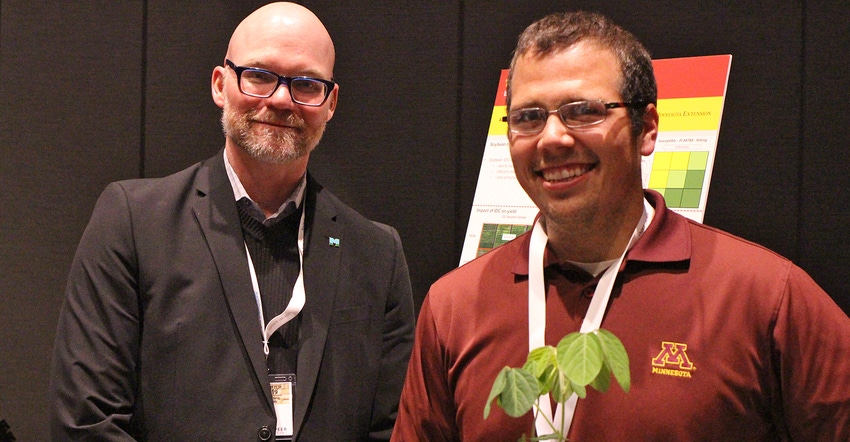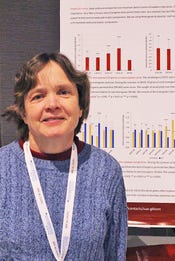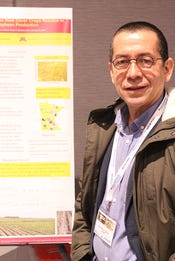February 5, 2019

By Jonathan Eisenthal
University of Minnesota scientists shared their latest research with farmers at MN Ag EXPO 2019 in Mankato on Jan. 23-24.
Corn research presentations focused on the various projects of the Center for Sustainable Polymers, a cross-disciplinary group of chemists, chemical engineers and other scientists who are working on ways to replace petroleum-based plastics and industrial compounds with products sourced in renewable feedstocks, like corn and soybeans.
Soybean research ran the gamut. One professor is investigating a promising new transgenic soybean, another is looking at the intersection of iron deficiency chlorosis and soybean cyst nematode, and another is figuring out how much residual nitrogen cover crops planted in soybeans scavenge, thereby making it available to the next cash crop.
Professor Sue Gibson has been working for number of years with a gene sequence taken from the mustard plant, Arabadopsis, which she inserted into soybeans. The gene, called LUCI-1, regulates the amount of sugar in the plant.
“We saw increased yields anywhere from a few percent up to double in one line, but I wouldn’t count on that,” Gibson said. “This is being done at a fairly small scale, so there is a level of error at this point. We have done trials now for two seasons. I think a yield increase of 20% would be something more realistic to shoot for.”
She used a common soybean variety, Willis62, because it was accessible and economical. Eventually, Gibson would like to try splicing the gene into more elite varieties of soybean that farmers would actually plant in Minnesota.
 SWEETEN SOYBEAN YIELDS: U-M scientist Sue Gibson is evaluating a mustard plant gene sequence inserted into a soybean variety to see if it enhances soybean yield.
SWEETEN SOYBEAN YIELDS: U-M scientist Sue Gibson is evaluating a mustard plant gene sequence inserted into a soybean variety to see if it enhances soybean yield.

Two of the biggest head-scratchers for soybean growers are iron deficiency chlorosis (IDC) and soybean cyst nematode (SCN). Associate professor Seth Naeve said the two conditions often occur together, so he and graduate student Austin Dobbels have been investigating how they relate and what treatments might be found that could cure both at once.
Also, they want to root out any treatments or agronomic practices that amplify the problem. They are bringing to bear the latest technologies, including normalized differential vegetative index (NDVI) imagery — a technology that blends infrared and red spectrum imagery.
“As growers know, variety selection is the best management tool out there for chlorosis,” Dobbels said. “In calcareous soils, the farmer chooses IDC tolerant varieties to head off the problem. They are also using chelates.”
Naeve said they looked at how many farmers used chelates to treat IDC and decided they should include it in their research protocol, so that they could take chlorosis out of the picture in some of the plots and put a laser-focus on SCN.
Nitrogen scavengers
In plots around the state, a cover crop blend of cereal rye, crimson clover and forage radish planted into soybeans is showing promise in scavenging residual nitrogen to hold and deliver it to the next season’s cash crop, said Axel Garcia y Garcia, an assistant professor in the agronomy and plant genetics department at the University of Minnesota’s Southwest Outreach and Research Center near Lamberton.
“Cereal rye produces much more biomass than other cover crops, so it actually uses more residual nitrogen than the other cover crops,” Garcia said. “From my three years of research, we have seen that cereal rye has been using, at the time of termination, 45 to 50 pounds of nitrogen per acre. That doesn’t mean that those 45 to 50 pounds are going to be available for the next crop. That is what this research is about. We are trying to determine how much of that nitrogen is going to be available for the next crop.”
This can represent a valuable input for the farmer while preventing nitrogen from becoming a pollutant in water resources, he added.
“On average, we might be able to reduce as much as 25% of the nitrogen loss through cover crops alone,” Garcia said.
Several of the corn-based research projects at the University of Minnesota Center for Sustainable Polymers focus on a highly valuable chemical process.
“We are looking at the process of converting lactic acid to acrylic acid,” said graduate student Yutong Pang. “Making lactic acid from fermentation of corn has been optimized to 90%, but then the step of taking lactic acid to acrylic acid has not been economically feasible because of an unwanted side reaction. Our research found that with the use of amines, we can reach 80% yield. We estimate that process optimization could create an annual market of $23 billion for corn-based acrylic acid.”
Pang did a top-of-the-envelope calculation and estimated this might translate to 100 million bushels of corn needed to make acrylates.
“[These are] super-absorbent polymers,” added Gereon Yee, who is working on a related project at the center. “The biggest application is diapers. They are also used in adhesives, sealants, coatings. You can make plastic materials out of them as well. Plexiglas is one of the most widely appreciated applications of an acrylate polymer.”
Now patented, the project uses a hydro-esterification process that creates carboxylic acid — another very valuable commercial material — along with the acrylate. You can couple any of a number of compounds into the process to get a different type of carboxylic acid, each with its own industrial application. One of the coupling materials would be oleic acid, which is derived from soybeans.
“Minnesota is well-poised to be the supplier for the raw materials for this process,” says Yee, noting that use of local resources is a key principle in the idea of sustainability.
 N SCAVENGER: U-M scientist Axel Garcia y Garcia is conducting research to see if cover crops planted into soybeans can capture residual nitrogen in the soil and hold it for the next season’s crop.
N SCAVENGER: U-M scientist Axel Garcia y Garcia is conducting research to see if cover crops planted into soybeans can capture residual nitrogen in the soil and hold it for the next season’s crop.

PLA — a corn-based plastic marketed by Minnesota-based NatureWorks — is widely considered a wonder material, yet some of its characteristics have prevented its use in some of the more lucrative markets for plastic. It is well-suited to making rigid containers. However, it is too brittle for other uses. That’s where research into a blended plastic — PLA with a small amount of plastic that gives it rubber-like texture — opens up much larger opportunities.
Market expansion
Finding value-added uses for corn is needed during times of depressed market prices and to avoid crop stockpiling, said Paul Meints, research director for Minnesota Corn Research & Promotion Council. Growers appreciate the plastics research conducted at the Center for Sustainable Polymers.
“Producing the foundation molecules of plastics from sustainable sources means they are both green in the production of the material, and after use, these materials are compostable,” Meints said. “They are not going to sit in a landfill for 10,000 years. They are going to have a quick breakdown in composting or they break down naturally, via a period of exposure to sunlight. That’s good for the environment, and that part of adding value to the corn grower is exciting to us.”
Eisenthal writes from St. Paul, Minn.
You May Also Like




